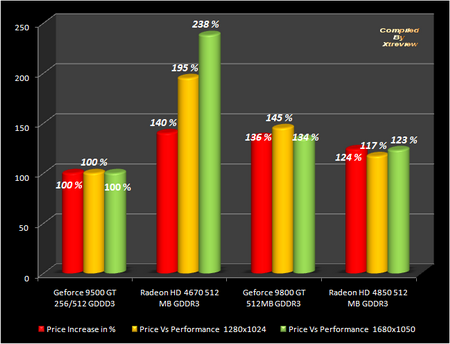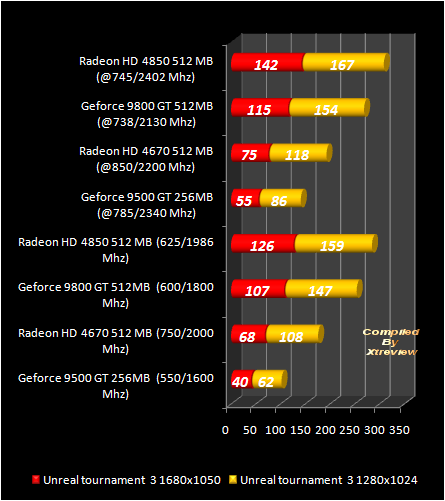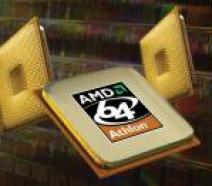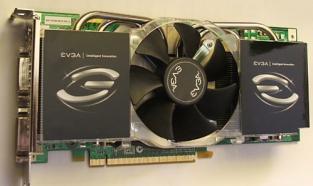RADEON HD 4670 VS GEFORCE 9500 GT VS GEFORCE 9800 GT VS HD 4850 OVERCLOCK BENCHMARK AND REVIEW
![]()
|
|
 |
|||||||||||||||||||||||||||||||||||||||||||||||||||||||||||||||||||||||||||||||||||||||||||||||||||||||||||||||||||||||||||||||||||||||||
| Posted:2008-10-10 By Video card review Number of View:429846 |
||||||||||||||||||||||||||||||||||||||||||||||||||||||||||||||||||||||||||||||||||||||||||||||||||||||||||||||||||||||||||||||||||||||||||
By :Video card review Posted:2008-10-10
The selection of video card in the average price segment is not so simple today. The recommended by NVIDIA AND ATi cost for the four video card are : GeForce 9500 GT, Radeon HD 4670, GeForce 9800 GT and Radeon HD of 4850 : lies in the range from 69 to 179 US dollars.
Logically many assume that the more expensive video card has a higher performance.
What is the NVIDIA GeForce 9800 GT? In essence this is the well known GeForce 8800 GT, but with the hybrid power technology support. For testing we got the OEM version . Inside the box besides the video card , one adapter 15 pin DVI/D -Sub, S -Video , CD with drivers and adapter for additional video card power :  This video card in not the reference design and it is based on PCB from sysconn development :
Immediately we note the two heat pipes:  Here is the video card without cooling system:  The power part include the six pin power connector :  According to NVIDIA specifications, in the load peak the GeForce 9800 GT consume less than 105 watts; therefore the requirements for power unit are sufficiently moderate (not less than 400 watts with 18-20 A on the 12v line). Here we have the G92 graphic processor A2 revision , released on 65- NM technical process in the week 32 last year:  The graphic processor frequency is 600 MHz, and its shader domain is 1500 MHz, which completely corresponds to the GeForce 9800 GT specifications . The GPU configuration include : 112 stream processors, 56 textural blocks and 16 blocks ROP\'s : identical to the GeForce 8800 GT. This video card is equipped with 8 chips memory GDDR3 standard with total volume 512 MB. The memory bus is equal to 256 bits. All microcircuits are located on the face video card side . Microcircuits are released by samsung company:  Chips Marking : K4J52324QE-BJ 1a : access time is equal to 1.0 NS with the theoretical effective frequency 2000 MHz. However, memory functions only at 1800 MHz, which also completely corresponds to the specifications Of GeForce 9800 GT/8800 GT. GPU- Z utility (version0.2.7) incorrectly detect this video card and considered that its graphic processor was equipped with 128 stream processors:  In spite of reference frequencies the cooling system is completely enough to rise the video card frequencies:  There was several issues in order to detect the correct video chip temperature since rivatuner do not support this video card and show 124c as GPU temp :  Note the video card PCB was not too hot . We swapped the default cooler with Arctic cooling accelero S1 and in this case the GPU temperature reached 99 degree Celsiuses:  Assuming that Accelero S1 proved to be up to 25 degrees better than the Sysconn cooler and using the this cooler on 8800 GT card the temperature do not exceed 56 C then with the reference cooler the card temp should be 81 c Under load. using Accelero S1 we was able to overclock this card to 738 MHz or + 21.3% (Shader domain to 1782 MHz or + 17.9%), and the video memory to 2130 MHz or + 18.3%:  In this case the GPU temperature in the peak load grew to 114 degree Celsius, which according to the previous calculation should be 71c :  The cost Of sysconn GeForce 9800 GT 512 MB is 149 US dollars, which corresponds to recommended by NVIDIA price .
Since His propose on the most advanced cooling for ATi radeon HD 4850 we decided to use this card on our review ; In this case the His HD 4850 card include the new IceQ 4 cooling system:
The box gives a detailed description of special video card features and its cooling system.  Here is the available accessory : 
This video card is even more beautiful than the Radeon HD 4670 from HIS .
Entire video memory is installed the PCB face side . Like all other video card on today\'s tests, HIS radeon HD 4850 IceQ 4 turboX is equipped with PCI-Express x16 version 2.0 interface and S -Video :  Here is the card without cooling system :  In the upper video card part are located two port for CrossFire regime or immediately four in the CrossFireX regime . The power part is made by four-phase power-supply ( usual 4850 adapts three-phase system) :  According to specifications, for Radeon HD 4850 512 MB it is necessary to have a power unit with 450 watts, and for CrossFireX- systems ( two video card ) a power unit with 600 watts will be required . RV770 Graphic processor is released on the 55- NM technical process in Taiwan on the 25Th week 2008:  The Crystal area is 256 sq. mm., and the number of transistors is approximately equal to 956 mln. in contrast to the Radeon HD 4850, GPU frequency 625 MHz, The video card from HIS has the increased to 685 MHz (+ 9.6%) graphic processor frequency ( 2d- regime 500 MHz ). The number of stream processors in RV770 graphic processor is equal to 800 pieces, textural blocks - 40, and ROP quantity is 16. Eight microcircuits for video memory GDDR3 standard are located in the face PCB side . HIS radeon HD 4850 IceQ 4 turboX use samsung memory:  Microcircuits Marking : K4J52324QH-HJ08, and their default access time it is equal to 0.83 NS, which corresponds to theoretical effective frequency 2400 MHz. Reference radeon HD 4850 are equipped with GDDR3 video memory with the default access time 1.0 NS (1986 MHz frequency ). However, in the case new video card from HIS has the video memory frequency 2200 MHz, which is 10.1% higher than reference. The memory bus is 256 bits. Video card specifications are the following:  Besides the high graphic processor frequencies and video memory, HIS radeon HD 4850 IceQ 4 turboX is equipped with original two-slot cooling system :
 The reference cooling system for the radeon HD 4850 is the weakest part of this video card. It is completely logical, after increasing the frequencies, HIS decided to install to its video card a alternative cooler . Two copper heat pipes with 6 mm diameter: 
The radiator base is made from copper :  Here is the fan:  The rotation speed is regulated automatically depending on the graphic processor temperature .
According to rivatuner , this cooling system works very effectively, since the temperature of the overclocked GPU did not exceed 66 degree :  With the maximum fan speed this temperature can be lowered by 10 degree Celsius:  However, the increased noise level is too high . In this case , IceQ4 loses on effectiveness and noise level arctic cooling accelero S1 with the turbo- module by 5 degrees under peak load ; Using Accelero S1 this processor preserves stability at 745 MHz frequency + 19.2% over the reference frequency for HD 4850, and video memory at the frequency 2402 MHz or + 21.0%:  The temperature conditions in this case was sufficiently modest:  Note overclocking using the cooling system IceQ 4 did not reveal any differences in the max overclocked frequencies.
What is ATi radeon HD 4670? In contrast to the GeForce 9500 GT, HD 4670 is based on the new graphic processor RV730, which is actually the reduced copy of the well known RV770 with 320 stream processors (instead of 800), with 32 textural blocks and with 8 blocks ROP\'s. The production technology is 55 NM. Radeon HD 4670 can be equipped with 512 MB video memory GDDR3 standard , or 1024 MB video memory DDR3 standard . In this case the memory bus is only 128- bit and the card frequencies are 750/2000 MHz. The maximum power consumption must not exceed 59 watts, and the recommended cost is 79 US dollars. This video card from high-tech information system limited company (HIS) is supplied in the small box, designed beautifully and maximally informative.
Inside the box are located : the video card itself , one adapter 15 pin DVI/D -Sub, adapter with DVI to HDTV, CD with drivers, overclocking utility and also the user instruction manual :  This card has a modest dimensions .
HIS radeon HD 4670 IceQ turbo is equipped with PCI-Express x16 version 2.0 , two ports DVI- I (dual-link) with high resolutions support , and also S -Video :  Here is the card without cooling system :  There are two ports CrossFireX. No additional power connector is required since the card power do not exceed 59 watts . The graphic processor was released in Taiwan 30Th week present year:  GPU Crystal area composes only 145 sq. mm. with 514 mln. transistors, this chip is released on the 55- NM technical process and saturated by 320 stream processors, 32 textural blocks and 8 blocks Rop\'s. The graphic processor frequency is 780 MHz, 30 MHz higher than the indicated in AMD specifications for the radeon HD 4670 (750 MHz). In the 2d regime the chip frequency is reduced to 168 MHz. HIS radeon HD 4670 IceQ turbo is equipped with 512 MB video memory GDDR3 standard.  Chips marking from hynix company production : H5RS5223CFR NOC. Their default access time composes 1.0 NS with the theoretical effective frequency 2000 MHz.  On HIS radeon HD 4670 IceQ turbo is installed a original cooling system VGA silencer from the Swiss company arctic cooling:  This cooler is very simple and it is for sure cheap, due to the light aluminum radiator.  The fan speed is constant and completely quiet . But here the cooler efficiency proved to be on the average level , since at the lowered to standard for Radeon HD 4670 frequencies the graphic processor temperature rapidly reached 74 degree Celsius:  Since Arctic cooling accelero S1 is not compatible with Radeon HD 4670 , we checked the overclocking potential of HIS radeon HD 4670 IceQ turbo using the standard cooler. It was possible to reach the frequencies 850/2200 MHz (+13.3/10.0%):  The operating temperature of the overclocked card did not change in the comparison with the default frequencies, peak GPU temperature grew by 2 degree Celsius only.
What is NVIDIA GeForce 9500 GT? this video card is based on the new cheap graphic processor G96, lowest price segment; therefore its productivity is more than modest at the contemporary level. The GPU include 32 universal stream processors, 16 textural blocks and 8 ROP\'s blocks Actually, this graphic processor G84 (GeForce 8600 GT/GTS), is released on 65/55- NM technology. The memory bus is 128- bit. The XFX video card is supplied in the compact bright box . There it is possible to reveal information about the video card series : XXX alpha dog.
The card come with 15 pin DVI/D -Sub adapter, cable S -Video, CD with drivers, User instruction and the overclocking utility: 
XFX GeForce 9500 GT XXX alpha dog is equipped with PCI-Express x16 version 2.0 , two yellow DVI- I (dual-link) ports with high resolutions support and video out:  Here is the card without cooler:  Plain PCB, minimum elements and maximally simple power system . There are no additional ports, except MIO for the SLI regime. The maximum video card power consumption does not exceed 50 watts; . The GeForce 9500 GT recommended a power unit with 350 W, which ensures 18-20 on the +12 v line. All is modest and simple. The G96 small graphic processor area composes only 144 sq. mm, the number of transistors is 314 mln. The chip marking G96-300-B1 speak, that it is released in Taiwan on the 65- NM technology :  But here according to core area and overclocking potential, before us the 55- NM chip. This graphic processor include 32 stream processors, 16 textural blocks and 8 blocks ROP\'s. The specifications Of the GeForce 9500 GT are 550/1375 MHz ; however, XFX company increased the frequencies of its XXX alpha dog version to 680/1600 MHz or + 23.6% and + 16.4% . The video memory frequencies are also increased . The card include four GDDR3 microcircuits from qimonda company with the total volume 256 MB:  Memory marking : HYB18H512321BF-10 , default access time is 1 vs, which corresponds to the theoretical effective frequency 2000 MHz. The memory in XFX GeForce 9500 GT XXX alpha dog functions at 1900 MHz, which up to 18.8% exceeds the GDDR3 frequency for reference GeForce 9500 GT (1600 MHz). The recommended cost Of the GeForce 9500 GT is equal to 69 US dollars. Thus, the technical characteristics of this card are :  The cooling system is simple and consists on aluminum radiator:   The fan from powerLogic company production (model PLD06010S12H) and consume not more than 3.6 watts :  The fan rotation speed varies depending on the graphic processor temperature . In the automatic operating mode the fan rotate at constant speed up to 50% of its power. Let us verify the temperature conditions of this video card. The graphic processor Load was with furMark version 1.4.0. Results at the reference GeForce 9500 GT frequencies with the automatic regime are :  Only 54 degrees in peak load , it is completely typical for video card and their reference cooling systems. increasing the rotation speed reduce the temperature by 2 degree Celsius:  Now we check the overclocking potential of XFX GeForce 9500 GT XXX alpha dog video card with reference cooler . The graphic processor frequencies was increased to 785/1850 MHz or + 43.3% (!) and + 34.8%, respectively to the reference frequencies GeForce 9500 GT, and the memory frequency to 2340 MHz (+ 46.3%)! No volt-mod and no replacement of cooling system!  … checking the temperature conditions:  Only 61 degree Celsius at such frequencies on the reference cooler in the quiet operation mode . Just awesome results 1. Technical characteristics, Recommaned cost and energy consumptionThe technical characteristics of all cards are represented in the following table:
We used the test Firefly forest from 3DMark 2006 in order to test the max power for all video cards . Here are the results:  The Radeon HD 4670 system whose consumption on the specifications is only 9 watts higher than the GeForce 9500 GT (59 against 50 watts), in the 3d regime is noticeably high, and in the 2d- regime and it proves to be the most economical (168 MHz only). The energy consumption level of the Radeon HD 4850 is lower than the GeForce 9800 GT. However, all four systems do not demonstrate a high energy consumption both in the load peak and in idle regime . 2. Test configuration :
The processor was overclocked to the frequency 4.03 GHz with 1.575 v:  The memory worked @ 1006 MHz with the lowered timing 5-4- 4-12 (Performance level = 7) with 2.25 v. All tests were executed in Windows vista ultimate edition x86 SP1. Here is the list of application/game used during this test : 3. Tests ResultsVideo cards are located on the ascending order according to their recommended cost and he frequencies. Thus, here is the list of video cards :
As before, first let us examine the testing results in two synthetic benchmarks:
 In first synthetic benchmark the video cards arrangement do not completely corresponds to their cost. The GeForce 9500 GT without overclock is the slowest card but after overclock it practically reach the performance level of the stock radeon HD 4670. But here the GeForce 9800 GT according to 3DMark its 2006 is equal to the more expensive Radeon HD 4850.
 In the newer synthetic 3DMark vantage all video cards were arranged according to their cost. The Most successful overclocking video card ( GeForce 9500 GT ) show a increase of ~30%, but this does not suffice to reach the performance of the radeon HD 4670. In this case the overclocked GeForce 9800 GT on the contrary show a similar performance as the Radeon HD 4850.
  The first surprises. The GeForce 9500 GT is up to four times weaker than the little more expensive Radeon HD 4670, which furthermore almost reach the performance of the GeForce 9800 GT. The radeon HD 4850 is almost 40% faster than the Geforce 9800 GT .
The advantage Of radeon HD 4670 above the GeForce 9500 GT triply exceeds the differences between these cards in price. And the impressive 9500 GT overclock does not allow to approach the performance of the HD 4670.
The 9500 GT overclock do not result is a considerable boost , All three remaining video cards were arranged according to their cost.
  In this test besides the failure Of the GeForce 9500 GT (in comparison with the little more expensive Radeon HD 4670), it is possible to note the equal performance between the Radeon HD 4670 and GeForce 9800 GT in AA and AF regime , while without filtrating the cheaper Radeon HD 4670 was slower than the GeForce 9800 GT. The fastest card today Radeon HD 4850 completely justifies its price, since its advantage over the 9800 GT is sufficiently significant. Actually, it is possible to say that the Radeon HD 4850 is only video card , which ensures a comfortable frame rate in all game regimes .
  Here all cards performance correspond to their cost .
  In this game the GeForce 9500 GT show a completely poor result . while the GeForce 9800 GT in the qualitative regime could outdistance even the Radeon HD 4850.

The speed Of the GeForce 9500 GT in Crysis is ultra low, such video card is far from the minimum games requirement . However, other participants are capable of ensuring some comfortable gaming without AA and AF .
  In the simple graphic regimes the overclocked GeForce 9800 GT is equal to the overclocked radeon HD 4850.
It is interesting that the GeForce 9800 GT in the popular today game S.T.A.L.K.E.R.: Clear sky is faster than the Radeon HD 4850.

There results from the GeForce 9500 GT are absent due to the slow performance almost 1 FPS no more . The Radeon HD 4670 in the most qualitative regime and 1680 X 1050 resolution is faster than the more expensive GeForce 9800 GT. ConclusionsHere is the combined chart : Stock : Overclocked :

For 40% additional cost with the Radeon HD 4670 (over the GeForce 9500 GT ) user obtain 95% higher performance in the resolution 1280 X 1024 and up to 138 % in resolution 1680 x 1050. Now for 36% additional payment for the GeForce 9800 GT over the radeon HD 4670, user will obtain 45- percent increase in 1280 X 1024 and + 34% in 1680 X 1050. At the same time, the Radeon HD 4850, which cost up to 24% more than the GeForce 9800 GT, user will get 17% boost @ 1280 X 1024 and 23% in 1680 x 1024 ( with the exceptions of S.T.A.L.K.E.R.: Clear sky and unreal tournament 3) So for gamer the 9800 GT has the best performance / price ratio , The radeon HD 4670 is good also for budget gamer and the Radeon HD 4850 for high resolution gamer . The 9500 GT is useless for gamer even if heavily overclocked , Do not waste your money and get the 4670 if u are very limited in budget .
we would be happy to answer for your question . if you have suggestion or comment
regarding this review our support would be glad to help just join our forum and ask u will get the best answer
to discuss check our forum section :-) RATE THIS REVIEW | ||||||||||||||||||||||||||||||||||||||||||||||||||||||||||||||||||||||||||||||||||||||||||||||||||||||||||||||||||||||||||||||||||||||||||
![]()

Radeon HD 4670 VS Geforce 9500 GT VS Geforce 9800 GT VS HD 4850 overclock benchmark and review
Radeon HD 4670 VS Geforce 9500 GT VS Geforce 9800 GT VS HD 4850 overclock benchmark and review


7600gt review
7600gt is the middle card range.
We already benchmarked this video card and found that ...

 geforce 8800gtx and 8800gts
geforce 8800gtx and 8800gts  Xtreview software download Section
Xtreview software download Section  AMD TURION 64 X2 REVIEW
AMD TURION 64 X2 REVIEW  INTEL PENTIUM D 920 , INTEL PENTIUM D 930
INTEL PENTIUM D 920 , INTEL PENTIUM D 930  6800XT REVIEW
6800XT REVIEW  computer hardware REVIEW
computer hardware REVIEW  INTEL CONROE CORE DUO 2 REVIEW VS AMD AM2
INTEL CONROE CORE DUO 2 REVIEW VS AMD AM2  INTEL PENTIUM D 805 INTEL D805
INTEL PENTIUM D 805 INTEL D805  Free desktop wallpaper
Free desktop wallpaper  online fighting game
online fighting game  Xtreview price comparison center
Xtreview price comparison center 

- The new version of GPU-Z finally kills the belief in the miracle of Vega transformation
- The motherboard manufacturer confirms the characteristics of the processors Coffee Lake
- We are looking for copper coolers on NVIDIA Volta computing accelerators
- Unofficially about Intels plans to release 300-series chipset
- The Japanese representation of AMD offered monetary compensation to the first buyers of Ryzen Threadripper
- This year will not be released more than 45 million motherboards
- TSMC denies the presentation of charges from the antimonopoly authorities
- Radeon RX Vega 64 at frequencies 1802-1000 MHz updated the record GPUPI 1B
- AMD itself would like to believe that mobile processors Ryzen have already been released
- AMD Vega 20 will find application in accelerating computations
- Pre-orders for new iPhone start next week
- Radeon RX Vega 57, 58 and 59: the wonders of transformation
- ASML starts commercial delivery of EUV-scanners
- The older Skylake processors with a free multiplier are removed from production
- Meizu will release Android-smartphone based on Helio P40
- AMD Bristol Ridge processors are also available in American retail
- The fate of Toshiba Memory can be solved to the next environment
- duo GeForce GTX 1080 Ti in GPUPI 1B at frequencies of 2480-10320 MHz
- New Kentsfield overclocking record up to 5204 MHz
- Lenovo released Android-smartphone K8



computer news computer parts review Old Forum Downloads New Forum Login Join Articles terms Hardware blog Sitemap Get Freebies






































